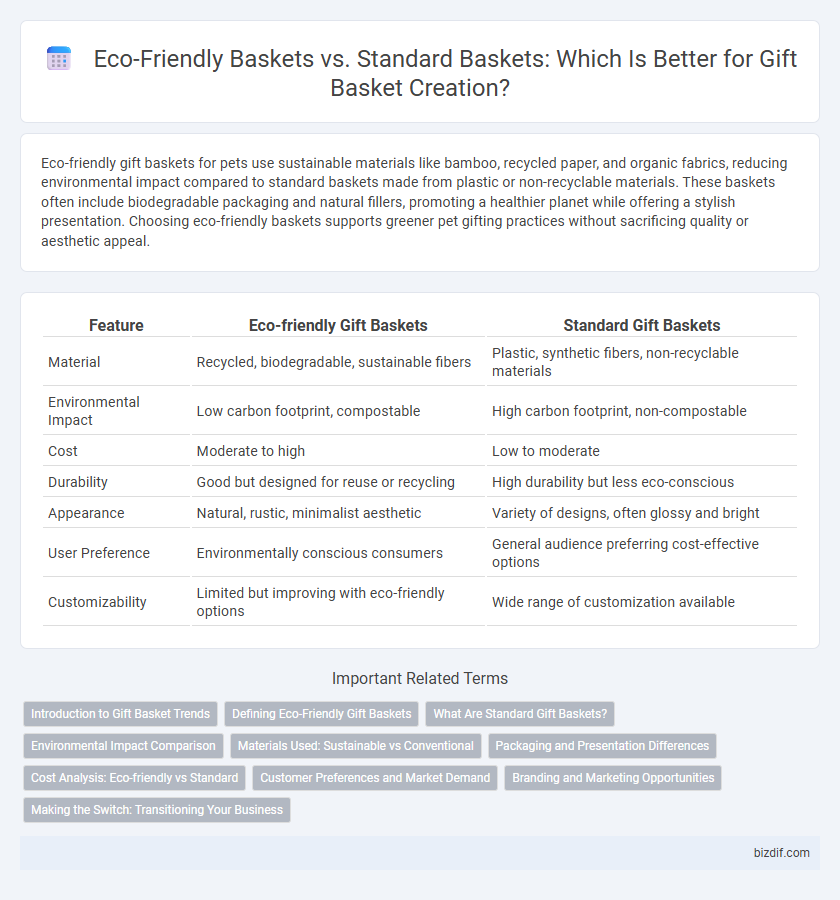Eco-friendly gift baskets for pets use sustainable materials like bamboo, recycled paper, and organic fabrics, reducing environmental impact compared to standard baskets made from plastic or non-recyclable materials. These baskets often include biodegradable packaging and natural fillers, promoting a healthier planet while offering a stylish presentation. Choosing eco-friendly baskets supports greener pet gifting practices without sacrificing quality or aesthetic appeal.
Table of Comparison
| Feature | Eco-friendly Gift Baskets | Standard Gift Baskets |
|---|---|---|
| Material | Recycled, biodegradable, sustainable fibers | Plastic, synthetic fibers, non-recyclable materials |
| Environmental Impact | Low carbon footprint, compostable | High carbon footprint, non-compostable |
| Cost | Moderate to high | Low to moderate |
| Durability | Good but designed for reuse or recycling | High durability but less eco-conscious |
| Appearance | Natural, rustic, minimalist aesthetic | Variety of designs, often glossy and bright |
| User Preference | Environmentally conscious consumers | General audience preferring cost-effective options |
| Customizability | Limited but improving with eco-friendly options | Wide range of customization available |
Introduction to Gift Basket Trends
Eco-friendly gift baskets are rising in popularity as consumers prioritize sustainability, using natural materials like bamboo, recycled paper, and organic products that reduce environmental impact. Standard baskets traditionally rely on plastic, synthetic fillers, and non-recyclable packaging, which contribute to waste and pollution. The shift towards eco-friendly options reflects a broader trend in gift basket creation, emphasizing green packaging and ethically sourced items to meet consumer demand for responsible gifting.
Defining Eco-Friendly Gift Baskets
Eco-friendly gift baskets prioritize sustainable materials like biodegradable or recycled fibers, avoiding plastics and synthetic fillers commonly found in standard baskets. These baskets often incorporate organic or locally sourced products, aligning with environmentally conscious consumer values and reducing carbon footprints. Choosing eco-friendly options supports waste reduction and promotes a circular economy, contrasting with traditional baskets that may contribute to landfill accumulation.
What Are Standard Gift Baskets?
Standard gift baskets typically feature non-recyclable materials such as plastic wrap, synthetic ribbons, and disposable containers, which contribute to environmental waste. These baskets often prioritize aesthetics and cost-effectiveness over sustainability, using items that are mass-produced and packaged with minimal regard for eco-impact. Choosing standard gift baskets can result in increased landfill waste and reduced recyclability compared to eco-friendly alternatives made from biodegradable or reusable materials.
Environmental Impact Comparison
Eco-friendly gift baskets significantly reduce environmental impact by utilizing biodegradable materials like recycled paper, natural fibers, and organic fillers, minimizing landfill waste and promoting sustainability. Standard baskets often rely on plastic, synthetic fabrics, and non-recyclable packaging that contribute to pollution and resource depletion. Choosing eco-friendly baskets supports carbon footprint reduction and encourages environmentally responsible gifting practices.
Materials Used: Sustainable vs Conventional
Eco-friendly gift baskets are crafted using sustainable materials such as recycled paper, organic fabrics, and biodegradable fillers, reducing environmental impact and promoting resource conservation. In contrast, standard baskets typically utilize conventional materials like plastic, non-recycled synthetic fibers, and foam, which contribute to landfill waste and pollution. Choosing sustainable materials supports eco-conscious gifting while maintaining aesthetic appeal and functionality.
Packaging and Presentation Differences
Eco-friendly gift baskets use biodegradable, recyclable, or reusable materials such as bamboo, jute, or recycled cardboard, reducing environmental impact while maintaining aesthetic appeal. Standard baskets often rely on plastic wrappers, synthetic ribbons, and non-recyclable fillers, which contribute to waste and limit sustainability. Presentation in eco-friendly baskets emphasizes natural textures and minimalistic designs, promoting a rustic, clean look compared to the glossy, mass-produced appearance of standard baskets.
Cost Analysis: Eco-friendly vs Standard
Eco-friendly gift baskets often have higher upfront costs due to sustainable materials like recycled paper, organic fillers, and biodegradable packaging, but they appeal to environmentally conscious consumers willing to pay a premium. Standard baskets typically feature cheaper synthetic or non-recyclable components, resulting in lower initial expenses but potential hidden costs related to environmental impact and brand reputation. Over time, eco-friendly baskets can provide better long-term value by aligning with growing market trends favoring sustainability and reducing waste disposal fees.
Customer Preferences and Market Demand
Eco-friendly gift baskets are increasingly preferred by environmentally conscious customers seeking sustainable packaging and natural materials, driving significant market demand growth. Standard baskets remain popular for their lower cost and traditional aesthetics but face declining interest as consumer awareness shifts towards eco-friendly options. The rising trend in zero-waste and biodegradable gift baskets highlights a strong market preference for products minimizing environmental impact.
Branding and Marketing Opportunities
Eco-friendly gift baskets enhance brand image by aligning with growing consumer demand for sustainable products, attracting environmentally conscious customers and increasing market appeal. Incorporating recycled materials and natural packaging in eco-friendly baskets differentiates brands from competitors, fostering stronger brand loyalty and positive social impact messaging. Standard baskets often lack this eco-conscious association, limiting marketing opportunities tied to sustainability and corporate responsibility trends.
Making the Switch: Transitioning Your Business
Transitioning your business to eco-friendly gift baskets enhances brand sustainability by reducing plastic waste and using biodegradable materials such as recycled paper and organic fabrics. Customers increasingly prefer eco-conscious options, boosting loyalty and expanding market reach with products that align with environmental values. Shifting supply chains to source sustainable components and redesigning packaging process are essential steps toward a greener, competitive gift basket business model.
Eco-friendly baskets vs Standard baskets Infographic

 bizdif.com
bizdif.com